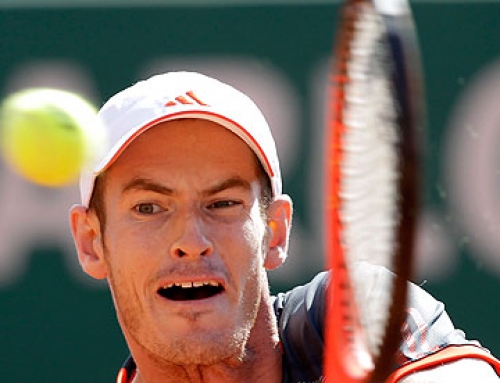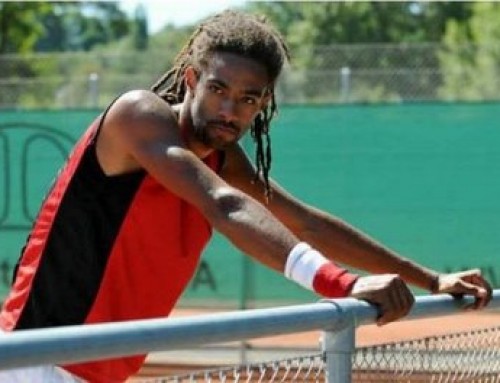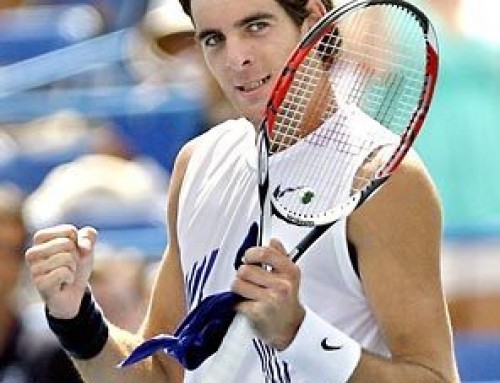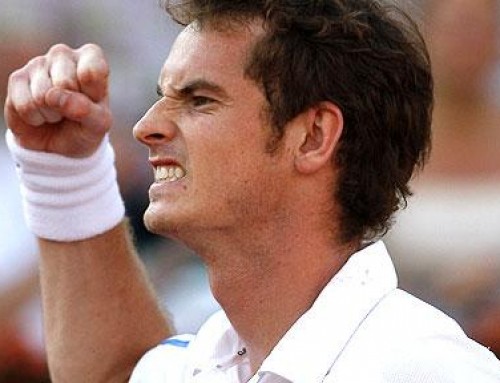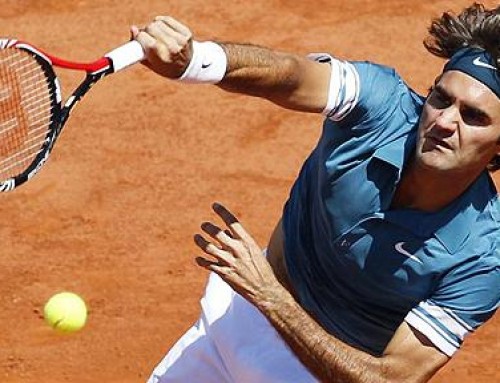 2008 was a big year for a number of players on the men’s tour.
2008 was a big year for a number of players on the men’s tour.
Juan-Martin del Potro came from nowhere to land in the top 10. Jo-Wilfried Tsonga used an Australian Open finals appearance and a solid indoor season to move there too. Countryman, Gilles Simon, played remarkably steady during the hard-court and indoor season to move into the top 10 as well.
Perhaps the most interesting change in ranking, despite the small bump in ranking from 6 to 4, Andy Murray’s leap may be the most significant. It’s hard to break into the top 10, but to break into the top 3 is even harder.
Most people make that jump early in their career. It’s a rare player to be in the top 3 whose talent nobody saw when they were 17 or 18 years old. Federer is a bit of an anomaly who didn’t start to make a huge impact until he was 21.
Andy Murray’s rise to number 3 in the world started with the hiring of Team Murray. Team Murray includes Miles Maclagan, his coach, Matty Little and Jez Green, his conditioning/fitness coaches, and Andy Ireland, his physiotherapist. Prior to this, Murray worked with Brad Gilbert. This change reflected a dissatisfaction with Brad Gilbert as his coach. Murray felt he was always having arguments with Gilbert, since Gilbert is strongly opinionated. He wanted someone that thought about the game like he did and someone he could discuss his game rationally with.
Murray started with his new team in late 2007 during the one month tennis off-season, December. His plan was to work training and fitness year-round, bringing his trainers to tournaments.
Things started off well in 2008. Murray won at Doha and Marseilles early in 2008 (on hard courts). But it took a while to get used to his new fitness routine. Murray wouldn’t win another title until Cincinnati in August. His Grand Slam record prior to Wimbledon was spotty. He lost in the first round of the Australian Open. A bad loss, it probably helped that Murray lost to eventual finalist, Jo-Wilfried Tsonga. In the French Open, he lost to Almagro in the third round. Despite his training, he didn’t get past the third round of any clay event in 2008.
Wimbledon was a big breakthrough for Murray. Often criticized for not fighting his way out of tough matches, he pulled out a 5-setter against Richard Gasquet. Gasquet was up 2 sets to none and serving for the match. Although Murray would end up losing in straight sets to eventual winner, Rafael Nadal, this win, on a surface that isn’t his best, was key, showing that he was heading in the right direction.
Despite his success at Wimbledon, Murray’s best surfaces are indoors and hard courts. His preference for hard courts goes back to the juniors. In the year that Monfils won 3 of 4 Grand Slam junior events, Murray won the 4th, which was the US Open.
Murray’s fitness program began to yield big results in the 2008 hardcourt season. He reached the semifinals in Toronto and won in Cincinatti, both Masters series events. Murray beat Djokovic twice both tournaments, a player he had had trouble with before. He would follow that with his biggest win, taking out Rafael Nadal in 4 sets in the US Open semifinals.
The real test of Murray’s preparation is how he fares on clay, his worst surface. Andy relies on the speed of the court to play aggressive when he needs to. The slow pace of clay means the prototypical clay grinder can stay even with Murray and not be fazed by his change of pace. On faster surfaces, Murray’s serve is more effective, and this makes it easier for him to hold serve.
Murray is a longshot to win the French or even reach the finals. Only a few weeks away, almost everyone thinks Nadal will win the French again. For Murray to win, he’d most likely have to beat Nadal, and lately, no one has made a huge impression on Nadal.
Let’s quickly review Nadal’s top rivals to win the French. Federer has been in the last 3 French finals against Nadal and has come second each time. Fed looked less than invincible in 2008, which was mostly blamed on mono that he got late in 2007. Despite uncharacteristic losses, Federer still had an amazing year in the Slams, reaching the AO semis, the French and Wimbledon finals, and winning the US Open. Still, most people felt Federer had slipped a notch, and he ceded number 1 to longtime rival, Rafa Nadal.
At the end of 2008, Federer injured his back. He’s mentioned in interviews that his back took longer to heal than expected which may contribute to his funk in 2009. People used to blame his losses to Nadal to Rafa’s mental edge. Fed could beat everyone else, but not Nadal.
However, by the end of 2008 and throughout 2009, Federer has now become vulnerable to Novak Djokovic and Andy Murray. He hasn’t beaten either one since the US Open, where he bat them both. People are no longer asking whether Federer will reach number 1 again, but whether he can stay at number 2. Djokovic and Murray are competing heavily to get that number 2 slot.
Despite these losses, Federer is unusually optimistic. He argues that his losses to Murray and Djokovic have been 3-setters and not blowouts. He feels that he is still the one who determines who wins or loses, not his opponent. Still, it would require a big effort for Federer to reach the finals of the French Open given he’s yet to reach a clay court final in 2009. It’s almost as if he’s avoiding Nadal until the French (in which case, one would expect Federer not to reach the finals of Madrid).
Based on current form, Novak Djokovic is Nadal’s closest rival. Close is, of course, relative. It’s like saying Serena is the closest woman to beating a male pro. It may be true, but Serena isn’t likely to beat any male pro soon.
In the 2009 clay court events, Djokovic has looked good for a set or a set and a half against Nadal, but Nadal manages to win the games when it matters most. Djokovic has to balance being aggressive against Nadal with making too many unforced errors, and right now, unforced errors have been his downfall.
In Monte Carlo, Novak took a set off Nadal, quite an accomplishment since Nadal hadn’t dropped a set since 2006. However, Novak lost the third set 6-1. Despite the blowout score, Novak had numerous chances to win games but nearly everyone went to Nadal.
In Rome, Djokovic managed to push Nadal to a tiebreak after being broken twice and then breaking back twice. However, Nadal won the tiebreak. Although Djokovic looked good in the early parts of the second set, Nadal again came through, and won the set 6-2. This is what happens when you play the king of clay. Close isn’t good enough.
There are some dark horses that might bother Nadal. Verdasco gave Nadal fits at the Australian, but has posed little challenge on clay. del Potro finally beat Nadal, but that was on the hard courts. Ferrer has looked more solid lately. James Blake(!) just won a clay event in Portugal and Tomas Berdych won one in Germany. These are smaller events with weaker fields, but an ATP win is still a confidence builder.
And where does Murray fit in all this? Murray knows clay is his worst surface. He gave Nadal a fight in Monte Carlo. On clay, Federer or Djokovic is probably favored over Murray. You’d give Murray the slight edge against these two on a faster surface.
Rather than play a lot of clay court events, a strategy that probaby wouldn’t help, Murray has only entered 3 clay court tournaments, all of them Masters series tournaments. He has entered Monte Carlo, Rome, and Madrid.
How has Murray fared? In 2008, he didn’t get past the third round of any clay event. He was hoping for a late round appearance in one of these events. In Monte Carlo, he reached the semis beating Davydenko en route (Davydenko had just returned to the tour). There, Murray predictably lost to Nadal, but pushed him to a tiebreak. That was a good result for Murray and gave him points on clay which he lacked from 2008.
In Rome, Murray lost in the second round to Juan Monaco of Argentina in 3 sets, a player he had beaten once on hard courts earlier in 2009, but not played since he was a junior training in Spain. He lost in the second round the previous year too, so he lost no points. Despite this early loss, Murray moved to number 3 because Djokovic failed to defend his title at Rome, losing (not surprisingly) to Nadal.
Murray’s has used the off weeks between Monte Carlo, Rome, and Madrid to work on his fitness and adjust his strategy to play on clay. He primarily trains in London with his team, working on both fitness and strategy, which he has tuned for the clay court season.
Murray stays loose during these practice sessions due to a variety of silly games his team plays.
Losers of these games must do silly things like wear women’s clothing, hose down the clay court, or get in an ice bath, post training, sans shorts. These are so-called forfeits.
How do I know these details? Am I chummy with Andy? Not at all. Unlike many of the top players, Andy Murray has been pretty open about his training. Like a few other celebrity athletes (most notably Shaquille O’Neal), Andy Murray uses Twitter. Twitter is considered a microblogging service. You are limited to 140 character updates. Murray often details the forfeits of the day via tweets giving his fans a peek at the life of a pro.
Andy Murray’s webpage details his training. Photos of Murray working in the gym, running on tracks, as well as some of the lighter moments. It’s surprising to see a top player this open about his training.
Can you imagine the reserved Roger Federer revealing how he trains? Federer protects his image zealously. You know there are things he wants to blurt out to the press, but he maintains an aura of diplomacy, much like Michael Jordan. This means, he says nice things rather than really say what’s on his mind. It’s hard to imagine Fed being as silly as Murray on his website. It’s just not in his nature.
It’s also hard to imagine Nadal, under the tutelage of Uncle Toni, revealing his training secrets. Nadal delegates a lot of his training to Uncle Toni who probably doesn’t want to say what he does to make Rafa so good.
Prior to 2008, Murray has been perceived as a whiner, a guy who gives up, a guy who wasn’t serious about his game. Murray had plenty of detractors prior to his rise in the rankings in 2008. His website and tweets may be part of a concerted effort to rehabilitate Murray’s image showing Andy is not only a good guy, but someone working really hard to move up the rankings. In the meanwhile, we, the public, get to see what goes behind the scenes of a top pro.
Will this training yield good results? Murray is playing in Madrid, where is defending champion. Unfortunately, it was an indoors event last year, and was converted to a clay event this year. With Nadal in the field, he’s unlikely to defend.
And his chances at the French? Murray would probably consider a semifinal appearance at the French as a huge success. Even a quarterfinal result would be pretty good. It will be interesting to see if his preparation leads to better results on clay. I can’t wait til the French to see if anyone is ready to take it to Rafa.



